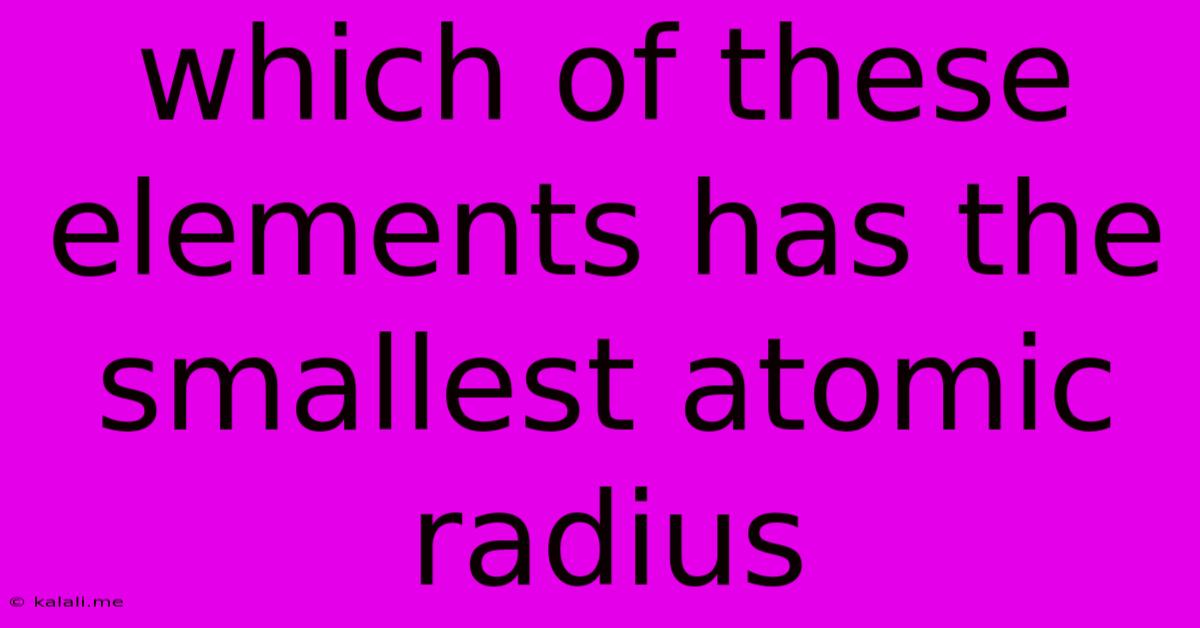Which Of These Elements Has The Smallest Atomic Radius
Kalali
Jun 15, 2025 · 3 min read

Table of Contents
Which of These Elements Has the Smallest Atomic Radius? Understanding Atomic Trends
Determining which element possesses the smallest atomic radius requires understanding the periodic trends influencing atomic size. This article will explore these trends, focusing on factors like effective nuclear charge and electron shielding, and ultimately answer the question: which element generally exhibits the smallest atomic radius? This will also cover how to compare atomic radii across periods and groups in the periodic table.
What is Atomic Radius?
Atomic radius refers to the distance from the atom's nucleus to its outermost stable electron. It's a crucial property influencing an element's chemical behavior and physical properties. It's important to remember that atomic radius isn't a fixed value; it can vary slightly depending on the atom's bonding environment. However, general trends allow us to compare the relative sizes of atoms.
Factors Affecting Atomic Radius:
Several factors play a significant role in determining an element's atomic radius:
-
Effective Nuclear Charge: This represents the net positive charge experienced by the outermost electrons. A higher effective nuclear charge pulls the electrons closer to the nucleus, resulting in a smaller atomic radius. This is influenced by both the number of protons and the shielding effect.
-
Electron Shielding: Inner electrons shield the outer electrons from the full positive charge of the nucleus. The more inner electrons present, the less effectively the nucleus attracts the outermost electrons, leading to a larger atomic radius.
-
Principal Energy Level (Shell): Electrons reside in energy levels or shells. As you move down a group (column) in the periodic table, you add another shell of electrons, increasing the atomic radius.
Periodic Trends and Atomic Radius:
The periodic table provides a roadmap for understanding atomic radius trends.
-
Across a Period (Left to Right): As you move from left to right across a period, the number of protons increases, leading to a stronger effective nuclear charge. While electrons are also added, they are in the same energy level. This increased attraction to the nucleus results in a decrease in atomic radius.
-
Down a Group (Top to Bottom): As you move down a group, you add electrons to a new, higher energy level, further from the nucleus. The increase in electron shielding outweighs the increase in nuclear charge, resulting in an increase in atomic radius.
Identifying the Element with the Smallest Atomic Radius:
Given these trends, the element with the smallest atomic radius will generally be found in the upper right-hand corner of the periodic table (excluding noble gases). This is because these elements have a high effective nuclear charge and minimal shielding. Helium (He) is frequently cited as having the smallest atomic radius, although Hydrogen (H) can be a close contender. The exact comparison between Helium and Hydrogen's atomic radius depends on the specific methodology used for measurement and often changes depending on the source.
Conclusion:
Understanding the interplay of effective nuclear charge, electron shielding, and principal energy levels is crucial for predicting atomic radius trends. While the specific values may differ slightly based on measurement methods, elements located in the upper right-hand corner of the periodic table, such as Helium, generally exhibit the smallest atomic radii. This knowledge forms the basis for understanding various chemical and physical properties of elements and compounds. Remember that this is a generalization, and subtle variations exist due to the complexities of atomic structure and interactions.
Latest Posts
Latest Posts
-
A Check Returned By The Bank Marked Nsf Means
Jun 15, 2025
-
What Is The Lcm Of 5 6 7
Jun 15, 2025
-
What Body Of Water Separates Africa From Europe
Jun 15, 2025
-
The Resistance And The Magnitude Of The Current Depend
Jun 15, 2025
-
The Graphic Representation Of Data In A Worksheet
Jun 15, 2025
Related Post
Thank you for visiting our website which covers about Which Of These Elements Has The Smallest Atomic Radius . We hope the information provided has been useful to you. Feel free to contact us if you have any questions or need further assistance. See you next time and don't miss to bookmark.